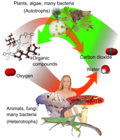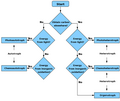Heterotroph: Difference between revisions
CSV import Tags: mobile edit mobile web edit |
CSV import |
||
| Line 39: | Line 39: | ||
[[Category:Organisms]] | [[Category:Organisms]] | ||
{{dictionary-stub1}} | {{dictionary-stub1}} | ||
== Heterotroph == | |||
<gallery> | |||
File:Auto-and_heterotrophs.png|Auto-and heterotrophs | |||
File:AutoHeteroTrophs_flowchart.png|AutoHeteroTrophs flowchart | |||
</gallery> | |||
Latest revision as of 21:01, 23 February 2025
Heterotroph is an organism that cannot manufacture its own food and instead obtains its food and energy by taking in organic substances, usually plant or animal matter. All animals, fungi, and most bacteria and protists are heterotrophs.
Overview[edit]
In the food chain, heterotrophs are primary, secondary and tertiary consumers, but not producers. Living organisms that are heterotrophic include all animals and fungi, some bacteria and protists, and many parasitic plants.
Types of Heterotrophs[edit]
Heterotrophs can be further classified based on how they obtain energy. If the heterotroph uses chemical energy from the environment, then it is considered a chemoheterotroph. Most animals and fungi are considered chemoheterotrophs. On the other hand, if the organism uses light for energy, then it is considered a photoheterotroph.
Chemoheterotrophs[edit]
Chemoheterotrophs obtain their energy by consuming organic molecules, which they break down through cellular respiration. These organic molecules can include fats, carbohydrates, and proteins.
Photoheterotrophs[edit]
Photoheterotrophs, on the other hand, use light energy to produce ATP but they cannot use carbon dioxide as their carbon source. Instead, they use organic compounds from the environment to satisfy their carbon requirements.
Role in the Ecosystem[edit]
Heterotrophs play a crucial role in the ecosystem. They are the consumers in the food chain, feeding on autotrophs and other heterotrophs to drive the energy flow through the trophic levels. They also help in decomposing organic materials, returning nutrients back to the ecosystem.
See Also[edit]
References[edit]
<references />





